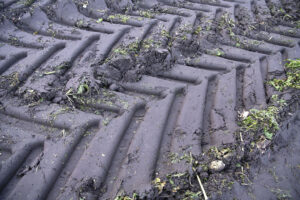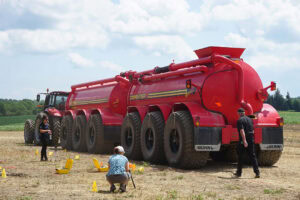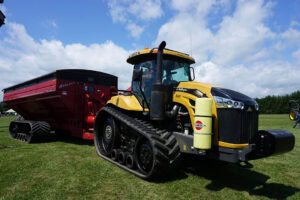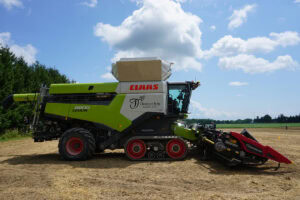Soil compaction 101

How does soil compaction happen, what does it do, and what prevention strategies and tools are available to farmers to dampen the effect of soil compaction?
Soil compaction is a real yield robber. It’s also detrimental to soil health overall, making for even longer-term negative impacts on production. While some compaction is inevitable, there are a variety of tools and strategies available to help reduce the significance and frequency of compressed soil – not to mention remedial measures.
Soil compaction defined

Soil compaction occurs when soil particles are compressed, reducing pore space. Heavily compacted soils contain few large pores, less total pore volume, and consequently, a greater density.
As described by University of Minnesota extension resources, bulk density measurements can reveal the amount of compaction in a given area. Soils with a higher percentage of clay and silt, which naturally have more pore space, have a lower bulk density than sandier soils.
Since large pores move water downward through the soil more effectively than smaller pores, compacted soil has a reduced rate of both water infiltration and drainage. The exchange of gases also slows in compacted soils, causing an increase in the likelihood of aeration-related problems. When it comes to crops, roots must exert greater force to penetrate compacted soil layer.
Some researchers estimate soil compaction can reduce yield as much as 60 per cent
How bad is it?
Compaction impacts everything, from soil health, nutrient uptake and crop emergence consistency to root development, yield, and overall crop energy. “Crop yields reduce when soil compaction decreases crop emergence, crop growth and nutrient uptake,” writes Jodi DeJong-Hughes, extension educator with the University. “Some researchers estimate soil compaction can reduce yield as much as 60 per cent. The ranges in yield effects are broad because compaction’s outcome is variable and due to many factors. Compaction’s effects aren’t consistent across the field.”
In the same extension article, DeJong-Hughs highlights a variety of research initiatives indicating the varied impact compaction has on yield. Research studies conducted in northern latitudes, for example, show the effect of severe subsoil compaction may affect crop yields for years. Research results from Lamberton and Waseca, Uppsala, Sweden and Quebec show a similar trend of initially lower yields following compaction with axle loads of 10 tons or more.
“The effect decreased over time, and yields on compacted soil approach the yields on non-packed soil after two to seven years, depending on the soil and climate. Soils higher in clay content recovered more slowly from the effects of compaction.”
Text continues underneath box
Soil compaction reducing tech

Compaction can occur at any time of year, and becomes more acute the wetter soil becomes. The increasing size of equipment in recent decades has made compaction issues worse. Neither deep tillage or a natural freeze-thaw cycle can be relied upon as solutions. However, some equipment technologies can help.
Machines designed with more uniform weight distribution in mind, for instance, remove acute pressure from specific parts of a machine (axles specifically).
Alex Barrie, a Canadian farmer and soil management engineer with the Ontario Ministry of Agriculture, Food and Rural Affairs, says modern combines are – despite frequently being the largest piece of machinery in operation – tend to have more uniform weight distribution than grain buggies and other farm implements. It’s the example which proves the rule, in that those in the market for new (or new-to-them) equipment may want to investigate the axel loads of potential purchases, or at least be aware of the unique characteristics of the implement.
Also read: Measuring soil compaction at planting
Conditions at planting tend to be wetter than at harvest, which has led companies like Fendt to invest in planter designs which actively redistribute weight. The weight redistribution, in-line wheel design, and automatic tire pressure of its Momentum brand planter line offers an example.
Like the Momentum planter system, equipment manufacturers and aftermarket product developers continue leaning into tire inflation-deflation systems. These allow operators to automatically increase tire pressure for road travel (adequate pressure is important for road safety), then expel that pressure before entering the field. With a wider base, the weight of a combine, tractor, grain buggy or other piece of machinery is distributed over a wider area.
Physically wider tires bring similar weigh distribution qualities, and are frequently employed on a variety of equipment. On sprayers – often an acute source of compaction – many operators have indeed found value in wider tires, though they can bring greater risk of crop damage due to trampling.
Tracks can similarly alleviate some compaction risk while allowing operators to work in more moisture-laden conditions. However, they are not inherently better than tires.

“Some new tires are trying to be more like a track for all the reasons tracks are good. Tracks are busy trying to get more of a rounded profile, like tires, for all the good reasons tires are good. The design elements are chasing each other,” says Barrie.“It really does come down to what you’re willing to put up with and what works for you. Getting them set up with the right air pressure for the weight you have is going to be the most helpful.”
With the ability to cover large distances with light burdens, or indeed, by not touching the ground at all, drones and smaller autonomous vehicles are other areas of development promising to alleviate compaction issues. The number and variety of equipment options in this vein of development continues to grow.
Analogue reduction techniques
Growers don’t require new technology to make gains in compaction reduction. Even without automatic inflation-deflation systems, Barrie says operators can save their soil a lot of trouble by regularly taking a tire pressure inventory.
“Make sure the tire pressure is adjusted. The heat during the day can affect it. It could be good in the morning, but several psi higher later in the day. That’s going to be quite significant in some cases. It’s about .3 per cent increase per degree Celsius, meaning you can have a three per cent change from morning till mid-day.” Not driving erratically or excessively within the field is also significant.
Greg Stewart, agronomy lead with Maizex based in Southwestern Ontario and active speaker at soil improvement events in the region, believes determining the preferred equipment path is a critical “gut” decision growers must make, particularly at harvest. Keeping traffic controlled to specific paths in and out of the field is usually, though not always the preferred choice.
The thinking is 80 per cent of compaction occurs in the first pass
“From a soil fitness perspective, the thinking is 80 per cent of compaction occurs in the first pass,” he says. “What critical threshold have you crossed? Even though 80 per cent occurs, if it’s only the next 20 per cent that causes yield reduction, you’d be happy to cause 80 per cent over the field. But if in that 80 per cent you’re causing yield reduction, you want to restrict pathways.”

“If you’re nervous about that first pass just by the look, moisture content, feel of the soil, what the depression looks like, you have to make a gut check whether you’re going to confine traffic to lanes or not be as concerned about it.”
Barrie adds developing practices to keep equipment movement as efficient as possible helps regardless of field conditions. This can include establishing additional field entrances to improve loading efficiency and reducing traffic, driving smoothly and without abrupt movements to minimize sudden weight shifts, or reducing equipment loading when operational efficiency will not be unduly impacted.
Both Barrie and Stewart agree, however, that employing patience and staying out of the field when conditions are not ideal is perhaps the most critical – and frequently sacrificed – factor.
Also read: Are light autonomous robots the answer to soil compaction?



